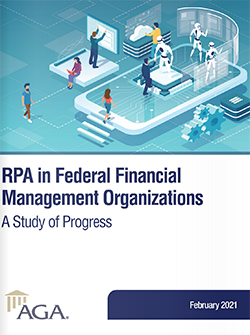
RPA in Federal Financial Management Organizations

One significant gain in productivity comes from robotic process automation (RPA). In 2020, the Association for Government Accountants (AGA) Corporate Partners Advisory Group (CPAG) Technology Committee studied the maturity of RPA in federal CFO organizations, and AGA released the results in February 2021. The report is entitled, “RPA In Federal FM Organizations: A Study of Progress.”
The AGA study team aimed to identify common successes and pain points in the use of RPA and provide useful lessons learned for FM organizations considering the next step in automation. The study focused on the federal FM community. Interviews were conducted with 14 FM organizations at varying levels of automation maturity. Most of these FM organizations had five or more robots (bots) in production at the time of the study.
RPA is a low- to no-code, commercial off-the-shelf (COTS) technology that can be used to automate repetitive, rules-based tasks. Processes best suited for RPA are high-volume, recurring tasks that may involve multiple legacy systems and manual processes. These processes may also require a large number of staff and significant attention to inaccuracies that can occur in rekeying data.
The study revealed many common themes among federal FM organizations that have launched successful RPA programs. For example, identifying a simple, well-documented business process to automate as a proof-of-concept was the most common approach to launching an RPA program. Strong organizational change management practices to alleviate staff fears about job security also led to greater success. As a result, most of the processes recommended for RPA came from staff. Good working relationships with other organizations, especially in the chief information officer (CIO) organization, also proved critical.
Study participants found it important to complete a thorough business case analysis to evaluate and prioritize processes recommended for RPA. Many agencies use an intake form to collect information about the business case. Data solicited from the potential users related to current pain points, baseline processes and steps, the owners of each step, and expected results of RPA. Using an intake form improved the value of the information and facilitated the implementation of new bots.
The study identified many challenges in implementing an RPA program, but the most common obstacles related to security. Many organizations underestimated the amount of effort required to attain authority to operate (ATO) for RPA software and automations. Several organizations faced similar challenges in assigning robots (bots) permissions to operate. Security challenges were much more prevalent for unattended bots, but RPA with attended bots also caused issues.
The study team asked participating organizations to perform a maturity assessment, using the criteria specified in the Federal RPA Program Playbook. The majority of organizations (77%) assessed their RPA programs at Level 1 (start-up) or Level 2 (emerging). Nearly a quarter (23%) gauged them at Level 3 (impactful); but none of the organizations judged their programs “high-performing” at Level 4. These results indicate the federal FM RPA journey is just getting started, and many opportunities to improve program efficiencies will materialize in coming years.
Study participants generally expressed a positive outlook on what they have achieved in RPA and optimism regarding the work still needed to improve their programs. Many said they believe their organizations are transitioning from one level to the next.
Two primary conclusions emerged from the study:
- Establish a multi-disciplinary team approach to accelerate FM RPA implementation and adoption. Encouraging participation among stakeholders affected by RPA will streamline evaluation and approval procedures, and it will accelerate the development and deployment of smart automation solutions. In addition, allocate time and resources to implement the right governance and pipeline management processes in establishing an RPA program to help it mature more quickly.
- Capture the time saved by automating repetitive tasks to measure return on investment (ROI) and document productivity. Evaluating the underlying problem(s) before applying a specific technological solution, plus documenting the business case and calculating an initial ROI, summed up the project’s value proposition and became de facto marketing tools to share with colleagues. An iterative approach, which starts small and builds upon success, is not only critical to learning and development, but also helps reluctant adopters recognize value in smart automation.
Many resources that detail best practices are available on RPA implementation, including some excellent resources from the Federal RPA Community of Practice (CoP). Delving into them can accelerate RPA program maturity.
Resources:
Federal RPA CoP. Federal RPA Program Playbook, January 15, 2020. The playbook offers detailed, user-friendly guidance for federal agencies to initiate new RPA programs or accelerate existing programs. https://digital.gov/pdf/rpa-playbook-v1.0.pdf
Federal RPA CoP. The State of Federal RPA: An Analysis of Governmentwide RPA Impact, Deployment, and Best Practices, November 1, 2020. This report covers RPA in multiple business functions, including federal FM. https://digital.gov/pdf/state-of-federal-rpa.pdf



